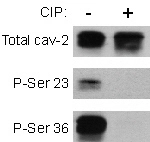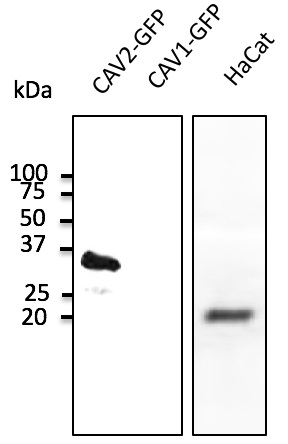
30 mg of lysates from LNCaP cells expressing caveolin-2 were incubated without (lane 1) or with calf intestinal phosphatase (CIP; lane 2) resolved on 12% SDS-PAGE, transferred onto nitrocellulose membrane, and western blotted with the following caveolin-2 specific antibodies: total caveolin-2 (non-phospho serine 23 GTX13542; top panel), phospho-serine 23 (GTX13543; middle panel), and phospho-serine 36 (GTX13544;? bottom panel)
Caveolin 2 (phospho Ser36) antibody
GTX13544
ApplicationsWestern Blot
Product group Antibodies
TargetCAV2
Overview
- SupplierGeneTex
- Product NameCaveolin 2 (phospho Ser36) antibody
- Delivery Days Customer9
- Application Supplier NoteWB: Use at a concentration of 0.1 - 1 microg/ml. Detects a band of approximately 24 kDa (predicted molecular weight: 18.2 kDa). Optimal dilutions/concentrations should be determined by the end user.
- ApplicationsWestern Blot
- CertificationResearch Use Only
- ClonalityPolyclonal
- Concentration0.5 mg/ml
- ConjugateUnconjugated
- Gene ID858
- Target nameCAV2
- Target descriptioncaveolin 2
- Target synonymsCAV, caveolin-2, caveolae protein, 20-kD
- HostRabbit
- IsotypeIgG
- Protein IDP51636
- Protein NameCaveolin-2
- Scientific DescriptionThe protein encoded by this gene is a major component of the inner surface of caveolae, small invaginations of the plasma membrane, and is involved in essential cellular functions, including signal transduction, lipid metabolism, cellular growth control and apoptosis. This protein may function as a tumor suppressor. This gene and related family member (CAV1) are located next to each other on chromosome 7, and express colocalizing proteins that form a stable hetero-oligomeric complex. Alternatively spliced transcript variants encoding different isoforms have been identified for this gene. Additional isoforms resulting from the use of alternate in-frame translation initiation codons have also been described, and shown to have preferential localization in the cell (PMID:11238462). [provided by RefSeq, May 2011]
- Storage Instruction-20°C or -80°C,2°C to 8°C
- UNSPSC12352203





